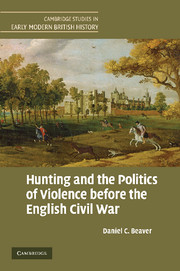Book contents
- Frontmatter
- Contents
- List of maps
- Acknowledgments
- List of abbreviations
- Introduction: Hunting, violence, and the origins of the English Revolution
- 1 Blood, sacrifice, and order: meanings of the forest and hunt in culture, politics, and society
- 2 Honor, property, and the symbolism of the hunt in Stowe, 1590–1642
- 3 Ancient liberties and the politics of the commonweal in Waltham Forest, 1608–1642
- 4 Royal honor, great parks, and the commonweal in Windsor Forest, 1603–1642
- 5 Venison and the politics of honor in Corse Lawn Chase, 1620–1642
- Conclusion: Royal symbols, forest politics, and popular politics in early modern England
- Bibliography
- Index
- Titles in the series
2 - Honor, property, and the symbolism of the hunt in Stowe, 1590–1642
Published online by Cambridge University Press: 06 March 2010
- Frontmatter
- Contents
- List of maps
- Acknowledgments
- List of abbreviations
- Introduction: Hunting, violence, and the origins of the English Revolution
- 1 Blood, sacrifice, and order: meanings of the forest and hunt in culture, politics, and society
- 2 Honor, property, and the symbolism of the hunt in Stowe, 1590–1642
- 3 Ancient liberties and the politics of the commonweal in Waltham Forest, 1608–1642
- 4 Royal honor, great parks, and the commonweal in Windsor Forest, 1603–1642
- 5 Venison and the politics of honor in Corse Lawn Chase, 1620–1642
- Conclusion: Royal symbols, forest politics, and popular politics in early modern England
- Bibliography
- Index
- Titles in the series
Summary
Some of them being armed with guns, some of them with swords, and some with clubs or pikestaves, were a hunting upon Sir Peter Temple's ground in the parish of Stowe, and killed a deer upon Sir Peter's ground, and gave out many bragging and daring words, some of them swearing that the deer was theirs and that they would carry him away or else they would lose their lives in the place.
John Symons, June 1642On 7 June 1642, John Symons, a servant of Sir Peter Temple, uttered this challenge, attempted to seize the deer, and received a painful blow to the head from John Rands, a servant of Peter Dayrell, his master's enemy. This violent wrangling over a dead animal in an obscure corner of northwestern Buckinghamshire may seem like a dubious place to begin a discussion of the common notions of order and hierarchy expressed in hunting. Most forms of violence, personal and collective, are taken as expressions of disorder, as evils usually banished from prescriptive notions of a rightly ordered world. John Symons himself held this view of the matter. According to Symons, the trespass on Sir Peter Temple's “ground” in Stowe, a disorderly and perhaps criminal action, caused the violent affray that culminated in the assault on his person. But even discounting Symons's obvious interest in redress for a sore head, violence is seldom construed as a part of the way order is made.
- Type
- Chapter
- Information
- Publisher: Cambridge University PressPrint publication year: 2008



